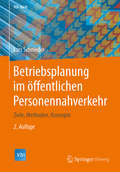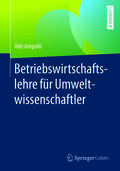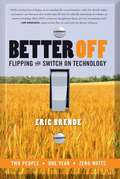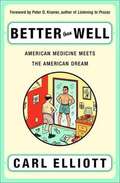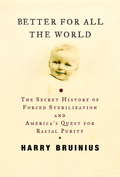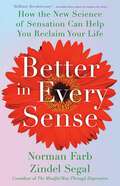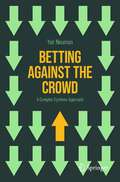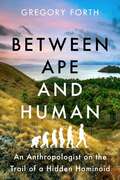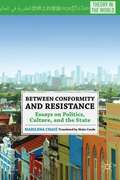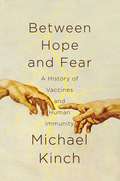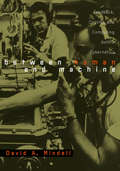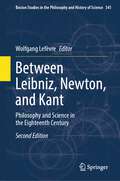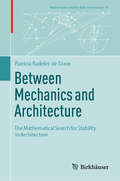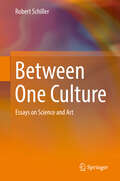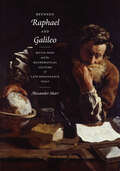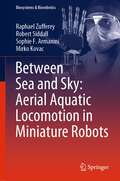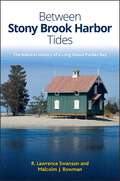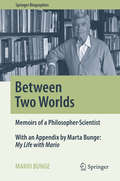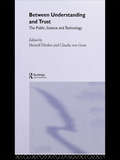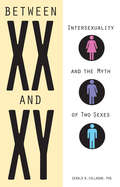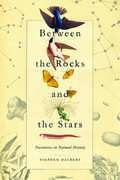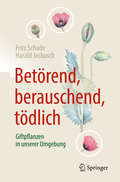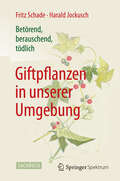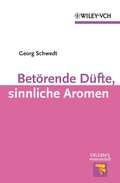- Table View
- List View
Betriebsplanung im öffentlichen Personennahverkehr: Ziele, Methoden, Konzepte (VDI-Buch)
by Lars SchniederMit diesem Buch erhält der Leser einen umfassenden Einblick in alle für die Planung, Durchführung und Kontrolle des Betriebs öffentlicher Personennahverkehrssysteme (ÖPNV) relevanten Aufgaben. Eine besondere Beachtung finden hierbei verkehrsträgerspezifische Besonderheiten, da der Betrieb des ÖPNV unterschiedlichen Randbedingungen und einer großen Bandbreite einwirkender Störgrößen unterliegt. Die vergleichende Darstellung der Merkmale der Verkehrsträger sowie deren Auswirkung auf die Betriebsplanung fördert das Verständnis der planerischen Aufgaben. Dieses Buch ist eine ganzheitliche und übersichtlich strukturierte Darstellung der einzelnen Planungsschritte in Verkehrsunternehmen in ihrem Zusammenhang. Vorhandene Methoden und Lösungsmöglichkeiten werden zusammengestellt und vergleichend diskutiert.Das Buch bietet beruflichen Neueinsteigern in die Verkehrsbranche eine gute fachliche Einführung in die Komplexität des Systems ÖPNV. Studierende und Lehrende an Hochschulen profitieren von einer strukturierten und ganzheitlichen Darstellung planerischer Prozesse. Für Ingenieurbüros und weitere am Planungsprozess Beteiligte (Politiker, Besteller, Ersteller) liegt der besondere Wert dieses Buches unter anderem in den umfangreichen kapitelbezogenen Literaturverzeichnissen begründet. Diese umfassen alle wesentlichen zum Fachgebiet gehörenden Schriften des zuständigen Verbandes und bieten auf diese Weise einen Ansatzpunkt für eine weiterführende Recherche.
Betriebswirtschaftslehre für Umweltwissenschaftler
by Ado AmpofoDieses Lehrbuch vermittelt Grundkenntnisse im Bereich der Betriebswirtschaftslehre für praxisnah ausgebildete Umweltwissenschaftler. Ein erfolgreiches Agieren als Mitarbeiter mit eigenem Verantwortungsbereich in einem Unternehmen ist ohne betriebswirtschaftliches Wissen praktisch unmöglich. Dies macht es für Fach- und Führungskräfte erforderlich, sich mit den grundlegenden Vorgängen und Zusammenhängen auseinanderzusetzen. Der Autor erläutert mit praxisrelevantem Fokus die Themenbereiche Marketing, Rechnungswesen, Rechtsformen, Forderungsmanagement, Steuern sowie Projekt- und Qualitätsmanagement. Auch die grundlegenden Herausforderungen des Umweltmanagements werden dargestellt. Ein ausführlicher Aufgabenteil mit Lösungen am Ende des Buches unterstützt die Lernkontrolle. Das Buch richtet sich an Umweltwissenschaftler, Umwelttechniker und Umweltingenieure, die die Grundlagen der Betriebswirtschaft erlernen möchten.
Better Off
by Eric BrendeWhat happens when a graduate of MIT, the bastion of technological advancement, and his bride move to a community so primitive in its technology that even Amish groups consider it antiquated? Eric Brende conceives a real-life experiment: to see if, in fact, all our cell phones, wide-screen TVs, and SUVs have made life easier and better -- or whether life would be preferable without them. By turns, the query narrows down to a single question: What is the least we need to achieve the most? With this in mind, the Brendes ditch their car, electric stove, refrigerator, running water, and everything else motorized or "hooked to the grid" and begin an eighteen-month trial run -- one that dramatically changes the way they live, and proves entertaining and surprising to readers. Better OFF is a smart, often comedic, and always riveting book that also mingles scientific analysis with the human story, demonstrating how a world free of technological excess can shrink stress -- and waistlines -- and expand happiness, health, and leisure. Our notion that technophobes are backward gets turned on its head as the Brendes realize that the crucial technological decisions of their adopted Minimite community are made more soberly and deliberately than in the surrounding culture, and the result is greater -- not lesser -- mastery over the conditions of human existence.
Better Than Well: American Medicine Meets the American Dream
by Carl ElliottPsychology aspects of medical options
Better for All the World
by Harry BruiniusA timely and gripping history of the controversial eugenics movement in America-and the scientists, social reformers and progressives who supported it. In Better for All the World, Harry Bruinius charts the little known history of eugenics in America-a movement that began in the early twentieth century and resulted in the forced sterilization of more than 65,000 people. Bruinius tells the stories of Emma and Carrie Buck, two women trapped in poverty who became the test case in the 1927 supreme court decision allowing forced sterilization for those deemed unfit to procreate. From the reformers who turned local charities into government-run welfare systems promoting social and moral purity, to the influence the American policies had on Nazi Germany's development of "racial hygiene," Bruinius masterfully exposes the players and legislation behind one of America's darkest secrets.
Better in Every Sense: How the New Science of Sensation Can Help You Reclaim Your Life
by Zindel Segal Norman FarbRenowned neuroscientist Dr. Norman Farb and clinical psychologist Dr. Zindel Segal reveal how to break out of negative patterns by engaging your senses. For many of us, daily life has stopped making sense. Super-efficient routines that once served us well now stress us out. Patterns of judgment and negative thinking lead to downward emotional spirals. For others, life has simply lost its spark. Where does change come from when habit lets you down? Whether we&’re struggling with a problem, a bad habit, or life in general, we often think we need to be resilient by &“toughing it out&” or &“trying harder.&” But when we do that, our brains double down on the thinking patterns that got us stuck in the first place—even when they clearly aren&’t working for us. Fortunately, the science of sensation provides the key. In Better in Every Sense, neuroscientist Norman Farb and clinical psychologist Zindel Segal explain that the brain has two networks—the rapid problem-solving (habit) network and the sensory network, which is devoted to fresh insight. By tuning into new and everyday sensations—from the feeling of our feet on a crowded street to the sound of birdsong in the park—we can engage the sensory network. When we&’re stressed or stuck, we can pause to notice and feel the dynamic, vibrant world around us and boost our resilience, well-being, health, and creativity wherever we are, in the moment. Grounded in decades of scientific research and filled with simple exercises and practical mental techniques for mastering &“sense foraging,&” Better in Every Sense explores the power of sensory experiences to liberate us from our ruts and dead ends—and help us successfully handle all of life&’s challenges.
Betting Against the Crowd: A Complex Systems Approach
by Yair NeumanCrowds are misleading, both in their simplicity and in their complexity. On the one hand, they behave according to expected trends; on the other, they present sudden shifts and frantic, unexpected behavior. Therefore, “betting against the crowd,” whether in politics, sports, or finance, requires a deep understanding of the crowd’s dynamics. In this book, Prof. Neuman addresses this challenge by delving into the complexity of crowds. The book involves foundational issues and novel ideas, such as why crowds behave unexpectedly, why betting against the crowd is possible only in short time frames, why is it important to be attentive to suspicious signs that are indicative of the crowd’s behavior, and why the long tail of fatalities in armed conflicts leaves us surprised by blitz attacks of violent mobs. The book combines scientific knowledge, experiments, and accessible, often humorous, exposition. It can be read by anyone with a basic science education who seeks to understand crowds and how one can act within and against them.
Between Ape and Human: An Anthropologist on the Trail of a Hidden Hominoid
by Gregory ForthA remarkable investigation into the hominoids of Flores Island, their place on the evolutionary spectrum—and whether or not they still survive.While doing fieldwork on the remote Indonesian island of Flores, anthropologist Gregory Forth came across people talking about half-apelike, half-humanlike creatures that once lived in a cave on the slopes of a nearby volcano. Over the years he continued to record what locals had to say about these mystery hominoids while searching for ways to explain them as imaginary symbols of the wild or other cultural representations. Then along came the &‘hobbit&’. In 2003, several skeletons of a small-statured early human species alongside stone tools and animal remains were excavated in a cave in western Flores. Named Homo floresiensis, this ancient hominin was initially believed to have lived until as recently as 12,000 years ago— possibly overlapping with the appearance of Homo sapiens on Flores. In view of this timing and the striking resemblance of floresiensis to the mystery creatures described by the islanders, Forth began to think about the creatures as possibly reflecting a real species, either now extinct but retained in &‘cultural memory&’ or even still surviving. He began to investigate reports from the Lio region of the island where locals described 'ape-men' as still living. Dozens claimed to have even seen them. In Between Ape and Human, we follow Forth on the trail of this mystery hominoid, and the space they occupy in islanders&’ culture as both natural creatures and as supernatural beings. In a narrative filled with adventure, Lio culture and language, zoology and natural history, Forth comes to a startling and controversial conclusion. Unique, important, and thought-provoking, this book will appeal to anyone interested in human evolution, the survival of species (including our own) and how humans might relate to &‘not-quite-human&’ animals. Between Ape and Human is essential reading for all those interested in cryptozoology, and it is the only firsthand investigation by a leading anthropologist into the possible survival of a primitive species of human into recent times—and its coexistence with modern humans.
Between Conformity and Resistance: Essays on Politics, Culture, and the State (Theory in the World)
by Marilena ChauíSince the 1980's, Marilena Chauí's writing has had a profound impact in Brazil, contributing to the academic conversation and resonating in popular culture. Here, in English for the first time, are ten of Chauí's most important essays, with an introduction by Maite Conde which situates the scholarship in the global context.
Between Hope and Fear: A History Of Vaccines And Human Immunity
by Michael KinchA smart and compelling examination of the science of immunity, the public policy implications of vaccine denial, and the real-world outcomes of failing to vaccinate. If you have a child in school, you may have heard stories of long-dormant diseases suddenly reappearing—cases of measles, mumps, rubella, and whooping cough cropping up everywhere from elementary schools to Ivy League universities because a select group of parents refuse to vaccinate their children. Between Hope and Fear tells the remarkable story of vaccine-preventable infectious diseases and their social and political implications. While detailing the history of vaccine invention, Kinch reveals the ominous reality that our victories against vaccine-preventable diseases are not permanent—and could easily be undone. In the tradition of John Barry’s The Great Influenza and Siddhartha Mukherjee’s The Emperor of All Maladies, Between Hope and Fear relates the remarkable intersection of science, technology and disease that has helped eradicate many of the deadliest plagues known to man.
Between Human and Machine: Feedback, Control, and Computing before Cybernetics (Johns Hopkins Studies in the History of Technology)
by David A. MindellToday, we associate the relationship between feedback, control, and computing with Norbert Wiener's 1948 formulation of cybernetics. But the theoretical and practical foundations for cybernetics, control engineering, and digital computing were laid earlier, between the two world wars. In Between Human and Machine: Feedback, Control, and Computing before Cybernetics, David A. Mindell shows how the modern sciences of systems emerged from disparate engineering cultures and their convergence during World War II. Mindell examines four different arenas of control systems research in the United States between the world wars: naval fire control, the Sperry Gyroscope Company, the Bell Telephone Laboratories, and Vannevar Bush's laboratory at MIT. Each of these institutional sites had unique technical problems, organizational imperatives, and working environments, and each fostered a distinct engineering culture. Each also developed technologies to represent the world in a machine.At the beginning of World War II, President Roosevelt established the National Defense Research Committee, one division of which was devoted to control systems. Mindell shows how the NDRC brought together representatives from the four pre-war engineering cultures, and how its projects synthesized conceptions of control, communications, and computing. By the time Wiener articulated his vision, these ideas were already suffusing through engineering. They would profoundly influence the digital world. As a new way to conceptualize the history of computing, this book will be of great interest to historians of science, technology, and culture, as well as computer scientists and theorists. Between Human and Machine: Feedback, Control, and Computing before Cybernetics
Between Leibniz, Newton, and Kant: Philosophy and Science in the Eighteenth Century (Boston Studies in the Philosophy and History of Science #341)
by Wolfgang LefèvreThis addresses the transformations of metaphysics as a discipline, the emergence of analytical mechanics, the diverging avenues of 18th-century Newtonianism, the body-mind problem, and philosophical principles of classification in the life sciences. An appendix contains a critical edition and first translation into English of Newton's scholia from David Gregory's Estate on the Propositions IV through IX Book III of his Principia.
Between Mechanics and Architecture: The Mathematical Search for Stability in Architecture (Mathematics and the Built Environment #8)
by Patricia Radelet-de GraveThis collection of essays reflects the author's decades-long dedication to studying the interplay between mechanics and architecture. It explores how advancements in mechanics have influenced architectural innovation and how the need for new architectural solutions has driven theoretical progress in engineering. By examining the historical roots of these fields, these essays provide a deep analysis of key developments. This interdisciplinary work will appeal to scholars, students, and anyone interested in the complex relationship between the theoretical and practical aspects of architecture and civil engineering.
Between One Culture: Essays on Science and Art
by Robert SchillerThis book argues that science and the arts are not two different cultures, but rather different manifestations of the same culture. Divided into seven parts, it presents a collection of translated and revised essays, mostly at the intersection between realia and humaniora. In the first two parts, the author discusses how some myths, both ancient and modern, have become intertwined with scientific ideas. The chapters in the following four parts address poems, novels, plays, and pieces of fine art that have some scientific content, as well as scientific findings which seem to have also been discovered in art. The chapters in the final part examine a number of inspiring doubts and necessary errors in the history of science. This collection of essays, most of which were originally published in Hungarian, is intended for the general public and as such includes no mathematical, physical or chemical formulae. It offers a unique resource for all those curious about the interconnections between science, art and literature.
Between Raphael and Galileo: Mutio Oddi and the Mathematical Culture of Late Renaissance Italy
by Alexander MarrAlthough largely unknown today, during his lifetime Mutio Oddi of Urbino (1569–1639) was a highly esteemed scholar, teacher, and practitioner of a wide range of disciplines related to mathematics. A prime example of the artisan-scholar so prevalent in the late Renaissance, Oddi was also accomplished in the fields of civil and military architecture and the design and retail of mathematical instruments, as well as writing and publishing. In Between Raphael and Galileo, Alexander Marr resurrects the career and achievements of Oddi in order to examine the ways in which mathematics, material culture, and the book shaped knowledge, society, and the visual arts in late Renaissance Italy. Marr scrutinizes the extensive archive of Oddi papers, documenting Oddi’s collaboration with prominent intellectuals and officials and shedding new light on the practice of science and art during his day. What becomes clear is that Oddi, precisely because he was not spectacularly innovative and did not attain the status of a hero in modern science, is characteristic of the majority of scientific practitioners and educators active in this formative age, particularly those whose energetic popularization of mathematics laid the foundations for the Scientific Revolution. Marr also demonstrates that scientific change in this era was multivalent and contested, governed as much by friendship as by principle and determined as much by places as by purpose.Plunging the reader into Oddi’s world, Between Raphael and Galileo is a finely wrought and meticulously researched tale of science, art, commerce, and society in the late sixteenth and early seventeenth century. It will become required reading for any scholar interested in the history of science, visual art, and print culture of the Early Modern period.
Between Sea and Sky: Aerial Aquatic Locomotion in Miniature Robots (Biosystems & Biorobotics #29)
by Raphael Zufferey Robert Siddall Sophie F. Armanini Mirko KovacThis book reports on the state of the art in the field of aerial-aquatic locomotion, focusing on the main challenges concerning the translation of this important ability from nature to synthetic systems, and describing innovative engineering solutions that have been applied in practice by the authors at the Aerial Robotics Lab of Imperial College London. After a general introduction to aerial-aquatic locomotion in nature, and a summary of the most important engineering achievements, the book introduces readers to important physical and mathematical aspects of the multimodal locomotion problem. Besides the basic physics involved in aerial-aquatic locomotion, the role of different phenomena happening in fluids, or those due to structural mechanics effects or to power provision, are presented in depth, across a large dimension range, from millimeters to hundreds of meters. In turn, a practice-oriented discussion on the obstacles and opportunities of miniaturization, for both robots and animals is carried out. This is followed by applied engineering considerations, which describe relevant hardware considerations involved in propulsion, control, communication and fabrication. Different case studies are analyzed in detail, reporting on the latest research carried out by the authors, and covering topics such as propulsive aquatic escape, the challenging mechanics of water impact, and a hybrid sailing and flying aircraft. Offering extensive and timely information on the design, construction and operation of small-scale robots, and on multimodal locomotion, this book provides researchers, students and professionals with a comprehensive and timely reference guide to the topic of aerial-aquatic locomotion, and the relevant bioinspired approaches. It is also expected to inspire future research and foster a stronger multidisciplinary discussion in the field.
Between Stony Brook Harbor Tides: The Natural History of a Long Island Pocket Bay (Excelsior Editions)
by Malcolm J. Bowman R. Lawrence SwansonWinner of the 2017 Robert Cushman Memorial Award presented by the Three Village Historical SocietyStony Brook Harbor, or Three Sisters Harbor as it was known historically, is perhaps the most pristine of the Long Island north shore pocket bays. Untouched by major commercialization, it has been designated a Significant Coastal Fish and Wildlife Habitat by the New York State Department of State and a Significant Coastal Habitat by the US Fish and Wildlife Service. Despite these designations, however, there is constant pressure to increase development of and around the harbor.Between Stony Brook Harbor Tides interweaves scientific understandings of the harbor with a consideration of its colorful history to inform and educate a general audience about its unique and delicate state. Data is used to illustrate the harbor's tides and currents and to show how they influence geological processes and pollution susceptibility. Storm surge measurements going back to the early 1990s document some of the extreme high waters experienced, and descriptions of some of the more interesting or important marine species of plants and animals found in the harbor are also included. The book discusses the century-long conflicts that local residents have fought in order to preserve this beautiful place, and it documents the tools that currently exist to help manage the harbor well into the twenty-first century. An excellent supplement to any high school or undergraduate environmental course, Between Stony Brook Harbor Tides provides readers with a basis for embracing the significance of the harbor and what it can bring to future residents.
Between Two Worlds: Memoirs of a Philosopher-Scientist (Springer Biographies)
by Mario BungeTo go through the pages of the Autobiography of Mario Bunge is to accompany him through dozens of countries and examine the intellectual, political, philosophical and scientific spheres of the last hundred years. It is an experience that oscillates between two different worlds: the different and the similar, the professional and the personal. It is an established fact that one of his great loves was, and still is, science. He has always been dedicated to scientific work, teaching, research, and training men and women in multiple disciplines. Life lessons fall like ripe fruit from this book, bringing us closer to a concept, a philosophical idea, a scientific digression, which had since been uncovered in numerous notes, articles or books. Bunge writes about the life experiences in this book with passion, naturalness and with a colloquial frankness, whether they be persecutions, banishment, imprisonment, successes, would-be losses, emotions, relationships, debates, impressions or opinions about people or things. In his pages we pass by the people with whom he shared a fruitful century of achievements and incredible depths of thought. Everything is remembered with sincerity and humor. This autobiography is, in truth, Bunge on Bunge, sharing everything that passes through the sieve of his memory, as he would say. Mario's many grandchildren are a testament to his proud standing as a family man, and at the age of 96 he gives us a book for everyone: for those who value the memories that hold the trauma of his life as well as for those who share his passion for science and culture. Also, perhaps, for some with whom he has had disagreements or controversy, for he still deserves recognition for being a staunch defender of his convictions.
Between Understanding and Trust: The Public, Science and Technology
by Meinolf Dierkes Claudia Von Grote'This is a welcome book. The issues of public understanding of science open many questions. What does "understanding" mean? How does understanding translate into attitudes towards science and trust in scientists? What is the role of the mass media? The essays in this book shed light on such questions bringing insights from several disciplines. They help to define a meaningful research agenda for the future. - Professor Dorothy Nelkin, New York University
Between XX and XY: Intersexuality and the Myth of Two Sexes
by Gerald CallahanProviding a fascinating look at the science of sex and what makes people male or female, this book explains dozens of intersex conditions--such as hermaphroditism, Klinefelter syndrome, and androgen insensitivity syndrome--and includes personal interviews with people living with these conditions telling their surprising and often heart-wrenching stories. Even doctors and scientists are not entirely sure if external genitalia, internal sex organs, chromosomes, DNA, environment, or some combination define a person's sex, but this examination shows that sex is not an either-or proposition: not girl/boy, XX/XY--there are babies born XYY, XXX, or with any dozen or more known variations in the X or Y chromosomes. The history and the current treatment for intersex conditions as well as the options that are available today for the ambiguous child are covered in this captivating account that truly shows what it means to be human.
Between the Rocks and the Stars: Narratives in Natural History
by Stephen DaubertThese stories take readers where they cannot go, be it out into space, back in time, deep under the ocean, down to micro-scopic scales, or out onto the geologic overview. Squid turn themselves inside-out when disturbed by predators hunting through the darkness with sonar. Beneficial microbes spend their summer living in nectar and being transferred between blooms by the bees, then spend the winter living within those bees. Ecological stories are seen through the eyes of squirrels, birds, fish, ants, butterflies, and beetles.Between the Rocks and the Stars dives deep into the relationships that shape the natural world. The book presents a collection of vignettes from the wild, each of which describes the natural advantage of a particular organism. These true-to-life accounts are then posed in particular circumstances that illustrate the principles—commensalism, speciation—that shape the place of these organisms in their living environment. Some stories cover topics in geology and cosmology, describing the physical world context in which natural history progresses across the eons. Underlying themes in the book include the network of connections that link all these organisms together and the adaptations they make to the physical world in which they must find themselves a home.
Between the Rocks and the Stars: Narratives in Natural History
by Stephen DaubertThese stories take readers where they cannot go, be it out into space, back in time, deep under the ocean, down to microscopic scales, or out onto the geologic overview. Squid turn themselves inside-out when disturbed by predators hunting through the darkness with sonar. Beneficial microbes spend their summer living in nectar and being transferred between blooms by the bees, then spend the winter living within those bees. Ecological stories are seen through the eyes of squirrels, birds, fish, ants, butterflies, and beetles.Between the Rocks and the Stars dives deep into the relationships that shape the natural world. The book presents a collection of vignettes from the wild, each of which describes the natural advantage of a particular organism. These true-to-life accounts are then posed in particular circumstances that illustrate the principles—commensalism, speciation—that shape the place of these organisms in their living environment. Some stories cover topics in geology and cosmology, describing the physical world context in which natural history progresses across the eons. Underlying themes in the book include the network of connections that link all these organisms together and the adaptations they make to the physical world in which they must find themselves a home.
Betörend, berauschend, tödlich - Giftpflanzen in unserer Umgebung
by Fritz Schade Harald JockuschWussten Sie dass durch Honig schon mal eine Schlacht entschieden wurde? dass sich das Reinheitsgebot für Bier ursprünglich gegen eine einheimische Rauschgiftpflanze gerichtet hat? dass der Wunderbaum Palma Christi ein Eiweiß produziert, das im deutschen Kriegswaffenkontrollgesetz aufgeführt wird? wieviele Pflanzen in Ihrem Hausgarten und in Parks giftig sind? Antworten auf viele spannende Fragen wie diese liefert das Giftpflanzenbuch von Fritz Schade und Harald Jockusch. Der Künstler Schade hat Giftpflanzen nach der Natur mit Farbstiften porträtiert, der Biologe Jockusch informiert über botanische, biochemische und toxikologische Fakten. Die Darstellungen werden durch historische Rückblicke, Anekdoten und eigene Erfahrungen aufgelockert. Im Buch folgt die Anordnung der Arten in etwa der jahreszeitlichen Abfolge des ersten Auftretens auffälliger giftiger Pflanzenteile. Wie die üblichen, mit Fotografien bebilderten Giftpflanzenratgeber dient ihr Buch der Gefahrenvermeidung, betont aber auch das Anschauungs- und Lesevergnügen.Die künstlerischen Darstellungen in diesem Buch verbinden ästhetischen Reiz mit hohem Wiedererkennungswert. Sie können leichter verinnerlicht werden als detailreiche Fotografien. Das gilt vor allem für Kinder, die durch Giftpflanzen besonders gefährdet sind. Neben der blühenden wird die fruchtende Pflanze dargestellt, wenn dies für die Vergiftungsgefahr relevant ist. In die 2. Auflage wurden 12 neue Pflanzenarten aufgenommen, von denen einige derzeit die Öffentlichkeit beschäftigen.
Betörend, berauschend, tödlich - Giftpflanzen in unserer Umgebung
by Fritz Schade Harald JockuschWussten Siedass durch Honig schon mal eine Schlacht entschieden wurde?dass sich das Reinheitsgebot für Bier ursprünglich gegen eine einheimische Rauschgiftpflanze gerichtet hat? dass der Wunderbaum Palma Christi ein Eiweiß produziert, das im deutschen Kriegswaffenkontrollgesetz aufgeführt wird?wie bezaubernd schön viele Giftpflanzen sind?Antworten auf viele spannende Fragen wie diese liefert das Giftpflanzenbuch von Fritz Schade und Harald Jockusch. Der Künstler Schade hat Giftpflanzen nach der Natur mit Farbstiften porträtiert, der Biologe Jockusch hat Fachwissen und Anekdotisches aus Gegenwart und Geschichte zu diesen Pflanzen zusammengestellt. Wie die üblichen, mit Fotografien bebilderten Giftpflanzenratgeber dient ihr Buch der Gefahrenvermeidung, betont aber auch das Anschauungs- und Lesevergnügen. Die Autoren beleuchten botanische, biochemische, historische und anekdotische Zusammenhänge für jede Pflanzenart und informieren so auf unterhaltsame Weise. Im Buch folgt die Anordnung der Arten in etwa der jahreszeitlichen Abfolge des ersten Auftretens auffälliger giftiger Pflanzenteile.Die künstlerischen Darstellungen in diesem Buch verbinden ästhetischen Reiz mit hohem Wiedererkennungswert. Sie können leichter verinnerlicht werden als detailreiche Fotografien. Das gilt vor allem für Kinder, die durch Giftpflanzen besonders gefährdet sind. Neben der blühenden wird die fruchtende Pflanze dargestellt, wenn dies für die Vergiftungsgefahr relevant ist.
Betörende Düfte, sinnliche Aromen (Erlebnis Wissenschaft)
by Georg SchwedtWhy do we find some aromas pleasant, sensual or even bewitching, while we turn our nose up at others? Top-selling author Georg Schwedt teaches scientifically-minded readers about scents and perfumes, aromas and spices. In a clever mixture of exact science and entertaining information he describes the manifold facets of the chemistry behind aromas. Topics range from the physiology of smelling, via methods of extracting scents and the creation of ethereal oils right up to such perfume icons as Chanel No. 5 or Tosca. Along the way Schwedt he uncovers fascinating facts from the culture and science of yesteryear and combines these with the latest results from chemistry. As a result, the reader learns about ancient Egyptian methods for making perfume and about the therapeutic use of scents, which can also be experienced in perfume museums.
